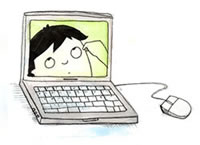Why Singapore’s English Teachers Should Embrace Singlish, Not Fight It
Is it time for Singaporean educators to embrace Singlish as a legitimate learning tool? What the Research […]
Read More
Critical thinking in an age of digital convenience: just a contradiction or a productive coexistence? SMART Technologies CEO Nancy Knowlton helps us answer some of the common dilemmas of teaching thinking with technology.

 Advancements in technology have definitely made life easier, faster and more convenient.
Advancements in technology have definitely made life easier, faster and more convenient.
While we are well aware of how this has changed classroom teaching, many are still unsure of how it helps achieve the other demands of the modern world – such as the need for students to think critically, be creative, and construct their own learning.
How do we teach a generation of digital natives to be tech-savvy but not spoon-fed? We asked SMART Technologies CEO Nancy Knowlton to answer some of the common questions on teaching thinking with technology.
A: Technology does make things easier for people, but it is not an end in itself. Technology is there to serve the needs of students and teachers, and aid the learning process. At SMART we believe that a teacher, trained and comfortable using a SMART Board™ interactive whiteboard, is better able to engage and motivate his or her students in whatever subject is being taught. Studies from around the world have confirmed this.
Once a student is engaged, I think most teachers, relying on their professional skills to create authentic learning experiences, will find it easier to stress important concepts like critical thinking.
Technology opens the window to a vast array of information. It is still the teacher’s role to stress the importance of questioning, evaluating and analysing this information.
A: First and foremost, using technology in the classroom means that there are tools and resources in students’ hands that allow them to fully explore their theses and ideas. Students aren’t limited by the resources that are housed in their libraries. Add a skilled teacher-librarian into the equation and these students can leap ahead in their thinking and creating.
The foundation here, though, is a teacher who structures pedagogically sound learning experiences to develop these skills. The art of asking good questions and then helping to model the appropriate thinking processes is key. Then allowing children to share the knowledge they have constructed with their classmates through a technology-enabled environment provides rigour and challenge while developing good presentation skills.
A: That is entirely up to individual teachers or school administrators, but it likely is the way to go when moving to a digital world. Just as Cortez burned his ships when he reached the new world, using new technology in the classroom means that at least some of the old tools should be left behind.
There have been many great teachers who have stood in front of their classrooms, with a blackboard behind them, and ignited the will to learn in their students. This is often called the sage-on-the-stage model. They have lectured explained, questioned, challenged, prodded and developed generations of citizens and leaders. Students have written their notes, listened attentively, undertaken their assignments and moved on to become productive members of society. This model worked well for a long time.
While we may have a romantic belief that education remains the same today as when we attended school, the reality is that children have changed, and much of that change has to do with the pervasiveness of information and technology. What was once a useful teaching model in a less digital, less hectic world seems dated to children who have grown up with technology all around them and who cannot understand why they should leave it behind when they enter a classroom.
A: I would simply ask the following questions: Does this technology increase the engagement of my students in the subject? Does it motivate them? Does it increase their curiosity? Does it improve their level of participation? As a teacher, does it make my lesson planning more effective and easier? If the answer to those questions is “Yes”, the technology is worth using in the classroom.
In the absence of concrete answers, try out the products and see how everyone responds to them. And talk to other teachers to get their direct advice and input.
A: I will keep it all positive.